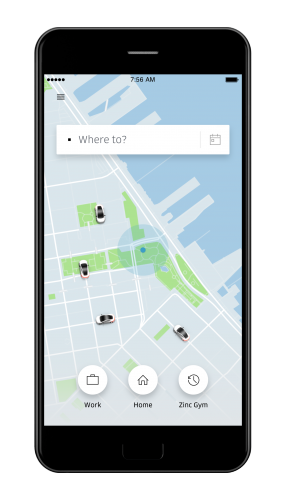Uber has sparked a revolution on the taxi services market. Their mobile app challenged the traditional taxi service with their user-friendly application interface and never-ending special offers.
The former failed to compete and were driven from the market as a result. At the same time, the emergence of similar businesses (Lyft, Curb, Didi, etc.) created extreme competition, forcing consumers to switch from one service provider to another depending on the price and quality of service.
Usability and simplicity are prevailing, so if you’re running a taxi business that got out of hand, then developing an Uber-like application is a must to raise income.
At IDAP, we have the professional tech expertise in building custom applications for business services. We have already implemented quite a few similar projects. Gained experience allows giving you an overview of how to develop a taxi app like Uber and how much it is going to cost.
Introduction to Uber
Uber is a taxi booking service that developed from the idea of accessing the cab whenever needed. It was firstly introduced to the vast audience in March 2009, and currently is the most popular taxi app in 108 countries.
How does Uber work?
The Uber application connects the client that tries to book a car to nearby drivers, estimates the approximate rate of a ride and the time of arrival. The app provides user with information about the driver including first name, type of the vehicle, the license plate number and telephone number. Therefore, it does everything to simplify the process of finding a safe ride.
After the user meets the driver on the pre-set pickup location, they can discuss the preferred road with a driver. The trip ends by arriving at the destination place. Fare is calculating automatically and charged by the payment method the user has selected in their Uber account. In some cities, Uber allows choosing between paying with card or cash. However, this option can be selected only before ordering a ride.
After the payment is complete, the app is going to offer a client to rate the driver from 1 to 5 Starts. Drivers are also asked to rate their riders. This way Uber creates the atmosphere of mutual respect, which is so often absent in traditional taxi service.
Building an Uber-like taxi application
The development of a taxi app involves:
- UI | UX Designer
- iOS | Android Developer
- Backend Developer
- Project Manager
- QA Engineer

Before the team gets down to business, the first thing to tackle is the set of functions that the app is going to implement. Do you want your application to be just-like Uber or your is goal to be a regular mobile app for taxi booking?
An Uber-like application consists of three separate blocks:
- Passenger’s application meant for ordering a ride;
- Driver’s application meant for getting an order and heading to the rider’s location;
- Admin dashboard.
Each of these blocks has a set of features that describe the app’s functionality. Some of them may overlap, while some will be unique. Deciding on the set of functions is necessary to estimate the approximate cost of development.
The Admin Dashboard is a web-based application that manages all in-app activities and provides access to the database. It helps to track the movements of passengers and drivers, and handle financial issues.
Let’s check out the list of an Uber app’s features:
1. Passenger App
- Registration: user can create a profile or register through a social media account.
- Booking: user can order a cab right now or set a certain time.
- Payment method: user can input his card information or choose to pay in cash.
- Push notifications: notify the user when the car is found or arriving.
- Ride history shows the information on previous trips.
- Fare calculator: calculates the approximate cost of the trip.
- Driver’s review and rating: user can revise comments about the driver, the car state and the overall impression left after the trip.
2. Driver App
- Registration and verification: driver provides personal data, license number plate, information on the car to become approved by the admin.
- Order alert: Notifies the driver about a new order for a trip, shows a pickup location, client’s contact information, and rating.
- Navigation: Shows the quickest path to the client, and then to the place of destination.
- Estimation: Ensures the trip was accordingly paid for.
- Report: Shows trips history and earnings.
3. Advanced features (Passenger App)
- Pickup location: User can point his exact location using the GPS module.
- Split payments: Divides the sum between a couple of riders and charges them separately.
- Selecting vehicle: User can choose a class of the car that is going to pick him up (e.g. UberSelect, UberBlack, UberLux).
- Tracking: Shows the driver’s location during the ride in real time.
- Discount: Gives a discount for a ride based on a promo code or a digital coupon.
Development Costs app like Uber
The Uber-like software has a primary task of delivering reliable transportation service at any time of the day. To make it possible, the application has to be easy to use, available on every platform, and process and store complex data, all while running multiple requests.

As of today, the Uber has made their APIs publicly available introducing a very beneficial affiliate program. With this, anyone can create a very simple Uber-like application. However, if you need a custom solution, we are going to briefly review the fundamental parts and calculate the cost of making an app like Uber.
Every application begins with:
1. UI/UX Design
To create a popular taxi booking application that is going to stand out from the crowd of similar services, one needs a unique while at the same time handy interface. It should be clean, intuitive in use and smoothly convey what goes after what. In short, it has to meet the key principles of excellent UI/UX:
- Clarity
- Flexibility
- Familiarity
- Efficiency
- Consistency
- Structure
Depending on the rates, design may cost from $2,800 ($35/hour) to $4,800 ($60/hour).
It includes the following stages:
- Analysis of the market and prospective consumer
- UX/UI design and usability testing
- Final product design
2. Maps and Directions
Essentially, the routing and GPS are the ones behind the popularity of taxi-booking applications. The user presses a few buttons and then observes how the taxi approaches the pick-up point.
GPS tracking determines the current location of a driver or a rider, gives directions and tracks the trip. The fare is also calculated relying on the given routing.
It is going to take about 20-40 hours to implement a location and routing features. Depending on the rates the cost ranges from $1,400 ($35/hour) to $2,400 ($60/hour).
Tech Stack applied:

IOS
CoreLocation Framework to monitor region MapKip Framework provides routes and directions Wi-Fi functionality to enhance location tracking.

Android
Google Location Services API to determine user’s location Google Maps Android API to suggest direction.
3. Payments
Uber has simplified the life of a regular taxi user with in-app payments. No longer there is any need to wait for change or be afraid of getting overcharged by the driver.
Users receive a pre-ride fare estimate and decide whether they want to order a taxi or not. The price depends on weather, traffic, a number of cars available, and discounts.
To offer the in-app payments, the company will have to meet the requirements of PCI (Payment Card Industry) compliance. If you want to provide safe and convenient payments, we recommend turning to such payment gateway providers like Stripe or Braintree. Especially Braintree, as it allows splitting the payment between several passengers. There are also such services as Google Wallet and Apple Pay, but for now they are available only in the USA.
Payment integration is a painstaking process that can take up to 80 hours of work. Depending on the rates the cost varies from $2,800 ($35/hour) to $4,800 ($60/hour).
4. Login and Profile
As with every application, a person has to create an account before using it. Apart from the usual email registration, it’d be great to give users a quick way out by logging with their social media accounts. However, the app should request access only to the necessary data and never post anything on the user’s behalf.
On the contrary, the app for a driver has to require more information than just a telephone number or an email. There should also be a photo, car license plate number, and a driver license number.
Developing the registration system is going to require between 100 to 120 hours. Depending on the rates the cost ranges from $4,200 ($35/hour) to $7,200 ($60/hour).
5. Communication
Setting up the push or SMS notifications is vital for setting the connection between the rider, driver, and the service. The app should send out simple push notifications e.g. information on the driver and car, the arrival of the driver, notify driver about new order waiting.
For Android, it can be implemented through Google Cloud Messaging Service, and on iOS it is carried out with Apple Push Notification Service.
In the case of Uber, there is a built-in messaging system, but developing this feature is going to require more time and funds. It can be considered after the project gets launched and gains popularity.
Aside from notifications, you may want to connect SMS messages. However, it is going to involve the agreement with telecommunication service provider and can be a quite nuisance for a user.
E-mail notifications are pretty outdated, but they are good for sending out special offers and trip receipts. It’s going to be particularly useful to those, whose taxi rides get reimbursed by employer.
The time needed for the development of push notifications begins at 5 hours.
Summary
The IDAP team would gladly provide you with an accurate project estimate based on your description and detailed product development roadmap.
It is difficult to calculate how much it costs to develop an app like Uber without knowing all specifications. To give out a clear estimate, we will have to clarify some details:
- Number of platforms (iOS, Android, Web) the app is going to be built for and its desired features.
- What exactly should the app do and how?
- Is it going to be a simple MVP or a complete business service?
- How many parties are going to be involved in the project?
In a nutshell, the cost of a plain Uber-like taxi application development begins at $20,000, while more refined solutions reach up to $100,000-150,000 or even more.
The IDAP team would gladly provide you with an accurate project estimate based on your description and detailed product development roadmap.



